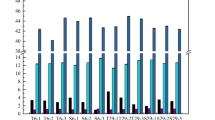Abstract
Sulfur compounds, such as sulfite (SO2), hydrogen sulfide (H2S), and glutathione (GSH), play different roles in beer flavor stability. SO2 and GSH have antiaging effects which are helpful to improve the flavor stability of beer, whereas H2S is undesirable to beer flavor because of its unpleasant aroma. Here, we report the development of Saccharomyces cerevisiae which produces higher levels of SO2 and GSH but lower level of H2S to improve beer flavor stability by nongenetic engineering approaches. After two rounds of UV mutagenesis coupled with specific plate screening methods, one promising mutant named MV16 was obtained. Compared with the original strain, the SO2 and GSH production of MV16 in fermenting liquor increased by 31% and 30.2%, respectively, while H2S content decreased by 74.9%, and the DPPH radical clearance and the resistance staling value of beer fermented by MV16 increased by 24.6% and 33.0%, respectively. The antioxidizability of the mutant was improved significantly. The strategy adopted in our study could be used to obtain S. cerevisiae of improved antiaging properties, and the mutant would be safe for public use.







Similar content being viewed by others
References
Wang, Z.-Y., He, X.-P., & Zhang, Bo-Run. (2007). Overexpression of GSH1 gene and disruption of PEP4 gene in self-cloning industrial brewer’s yeast. International Journal of Food Microbiology, 119(3), 192–199.
Yoshida, S., Imoto, J., Minato, T., Oouchi, R., Sugihara, M., Imai, T., et al. (2008). Development of bottom-fermenting Saccharomyces strains that produce high SO2 levels, using integrated metabolome and transcriptome analysis. Applied and Environmental Microbiology, 74, 2787–2796.
Thomas, D., & Surdin-Kerjan, Y. (1997). Metabolism of sulfur amino acids in Saccharomyces cerevisiae. Microbiology and Molecular Biology Reviews, 61, 503–532.
Murata, K., & Kimura, A. (1990). Overproduction of glutathione and its derivatives by genetically engineered microbial cells. Biotechnology Advances, 8, 59–96.
Hansen, J., & Kielland-Brandt, M. C. (1996). Inactivation of MET10 in brewer’s yeast specifically increase SO2 formation during beer production. Nature Biotechnology, 14, 1587–1591.
Tezuka, H., Mori, T., Okumura, Y., Kitabatake, K., & Tsumura, Y. (1992). Cloning of a gene suppressing hydrogen sulfide production by Saccharomyces cerevisiae and its expression in a brewing yeast. Journal of the American Society of Brewing Chemists, 50, 130–133.
Duan, W., Roddick, F. A., Higgins, V. J., & Rogers, P. J. (2004). A parallel analysis of H2S and SO2 formation by brewing yeast in response to sulfur-containing amino acids and ammonium ions. Journal of the American Society of Brewing Chemists, 62, 35–41.
Meister, A., & Anderson, M. E. (1983). Glutathione. Annual Review of Biochemistry, 52, 711–760.
Dormer, U. H., Westwater, J., McLaren, N. F., Kent, N. A., Mellor, J., & Jamieson, D. J. (2000). Cadmium inducible expression of the yeast GSH1 gene requires a functional sulfur-amino acid regulatory network. Journal of Biological Chemistry, 275, 32611–32616.
Baudouin-Cornu, P., & Labarre, J. (2006). Regulation of the cadmium stress response through SCF-like ubiquitin ligases: comparison between Saccharomyces cerevisiae. Biochimie, 88(11), 1673–1685.
Donalies, U. E., & Stahl, U. (2002). Increasing sulphite formation in Saccharomyces cerevisiae by overexpression of MET14 and SSU1. Yeast, 19, 475–484.
Omura, F., & Shibano, Y. (1995). Reduction of hydrogen sulfide production in brewing yeast by constitutive expression of MET25 gene. Journal of the American Society of Brewing Chemists, 53, 58–62.
Čmelík, Jiří., Machát, Jiří., Niedobová, Eva., Otruba, Vítězslav., & Kanický, Viktor. (2005). Determination of free and total sulfur dioxide in wine samples by vapour-generation inductively coupled plasma–optical-emission spectrometry. Analytical and Bioanalytical Chemistry, 383, 483–488. doi:10.1007/s00216-005-3382-2
Fogo, J. K., & Popowsky, M. (1949). Spectrophotometric determination of hydrogen sulfide. Analytical Chemistry, 21(6), 732–734.
He, X., Huai, W., Tie, C., Liu, Y., & Zhang, B. (2000). Breeding of high ergosterol-producing yeast strains. Journal of Industrial Microbiology and Biotechnology, 25, 39–44.
Liu, J., He, X., Wang, Y., Liu, Ch, Kong, Y., & Zhang, B. (2003). The breeding of high glutathione producing strain and optimization of culture condition. Acta Microbiologica Sinica, 43, 99–103.
Liu, J., Li, Q., Dong, J., Chen, J., & Guoxian, G. U. (2008). Multivariate modeling of aging in bottled lager beer by principal component analysis and multiple regression methods. Journal of Agricultural and Food Chemistry, 56, 7106–7112.
Singh, N., Sharma, R., & Balapure, A. (2007). pH regulated scavenging activity of beer antioxidants through modified DPPH assay. Toxicology and Industrial Health, 23(2), 75–81.
Ono, B., Ishii, N., Fujino, S., & Aoyama, I. (1991). Role of hydrosulfide ions in methylmercury resistance in Saccharomyces cerevisiae. Applied and Environmental Microbiology, 57, 3183–3186.
Thomas, D., Barbey, R., Henry, D., & Surdin-Kerjan, Y. (1992). Physiological analysis of mutants of Saccharomyces cerevisiae impaired in sulphate assimilation. Journal of General Microbiology, 138(10), 2021–2028.
Kobayashi, K., & Yoshimoto, A. (1982). Studies on yeast sulfite reductase IV. Structure and steady-state kinetics. Biochimica et Biophysica Acta, 705, 348–356.
Yen, J. L., Su, N. Y., & Kaiser, P. (2005). The yeast ubiquitin ligase SCFMet30 regulates heavy metal response. Molecular Biology of the Cell, 16, 1872–1882.
Acknowledgments
The authors thank Dr. Jun Lu and Dr. Jing Zou for the lively discussion and the valuable comments on the manuscript. The financial support of the 7th of the Young and Middle-Aged Talents Training Abroad Program of Tianjin Municipal Education Commission is gratefully acknowledged.
Author information
Authors and Affiliations
Corresponding author
Rights and permissions
About this article
Cite this article
Chen, Y., Yang, X., Zhang, S. et al. Development of Saccharomyces cerevisiae Producing Higher Levels of Sulfur Dioxide and Glutathione to Improve Beer Flavor Stability. Appl Biochem Biotechnol 166, 402–413 (2012). https://doi.org/10.1007/s12010-011-9436-3
Received:
Accepted:
Published:
Issue Date:
DOI: https://doi.org/10.1007/s12010-011-9436-3




